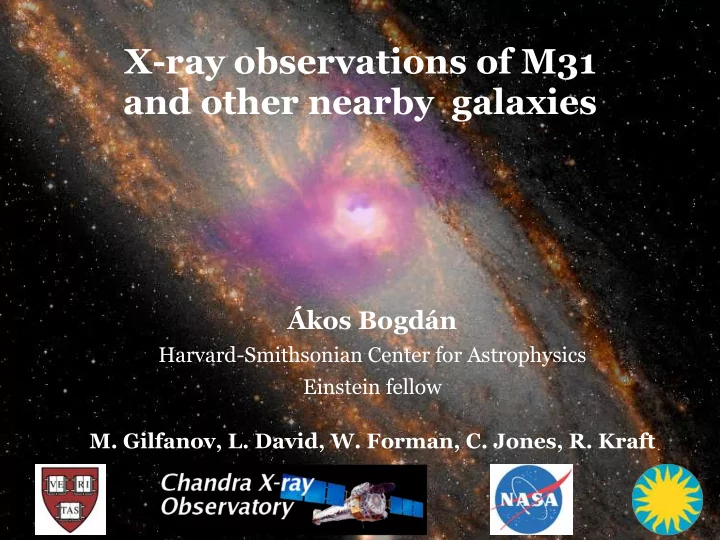

X-ray observations of M31 and other nearby galaxies Ákos Bogdán Harvard-Smithsonian Center for Astrophysics Einstein fellow � M. Gilfanov, L. David, W. Forman, C. Jones, R. Kraft �
Origin of X-ray emission from galaxies AGN • � X-ray binaries • Faint compact sources • Hot ionized gas • � Cosmic X-ray background • � Akos Bogdan Heidelberg, 7/17/2014
Low mass X-ray binaries � � Accreting BHs and NSs • � L X ~ 10 35 - 10 39 erg/s • � Resolved at the distance of • M31 luminosity function plot Gilfanov 2004 Revnivtsev et al 2006 Sazonov et al 2006 Akos Bogdan Heidelberg, 7/17/2014
Faint compact objects Cataclysmic variables and active binaries • L X ~ 10 27 - 10 34 erg/s • Remain undetected at the distance of M31 • Distribution follows the stellar light • Gilfanov 2004 Revnivtsev et al 2006 Sazonov et al 2006 Akos Bogdan Heidelberg, 7/17/2014
Hot ionized gas Sub-kev temperatures in galaxies • Amount of hot gas shows large variations • M32 M49 Revnivtsev et al. 2007 Kraft et al. 2011 No hot gas detected Large amount of hot gas • • Unresolved X-ray emission Gas dominates the X-ray • • from faint compact objects appearance Akos Bogdan Heidelberg, 7/17/2014
The bulge of M31 in X-rays Akos Bogdan Heidelberg, 7/17/2014
The bulge of M31 in X-rays w/o X-ray binaries Akos Bogdan Heidelberg, 7/17/2014
Surface brightness distribution Bogdan & Gilfanov 2008, 2010 Near-infrared traces the stellar light • Peak in the X-ray light distribution • Akos Bogdan
X-ray energy spectra Central region � Outer bulge region � Disk region � M32 Akos Bogdan Heidelberg, 7/17/2014
X-ray energy spectra Bogdan & Gilfanov 2008, 2010 Akos Bogdan Heidelberg, 7/17/2014
X-ray energy spectra Above 1.2 keV Below 1.2 keV � � • Good agreement • Soft excess component � • Varying strength • Can be fitted by • Complex spectrum powerlaw Bogdan & Gilfanov 2008, 2010 Akos Bogdan Heidelberg, 7/17/2014
X-ray emitting components 1. Broad band component • Large number of faint compact X-ray sources • Agreement between X-ray and NIR profiles • Normalized spectra are consistent with each other � 2. Soft emission in the central regions • Concentrated towards the center • Hot ionized gas � 3. Emission from star forming regions Akos Bogdan Heidelberg, 7/17/2014
Distribution of the hot gas Goal: remove X-ray emission from faint compact sources Gas distribution = X – N · NIR X-ray image in the 0.5-1.2 keV band Near-infrared image Normalization obtained from profile Akos Bogdan Heidelberg, 7/17/2014
Distribution of the hot gas DSS • Spitzer • Chandra • • kT ~ 0.3 keV • L X ~2 x 10 38 erg/s • M ~ 2 x 10 6 M sun • t cool ~ 250 Myears Bogdan & Gilfanov 2008, 2010 Li & Wang 2007 Akos Bogdan
Mass and energy budget of the outflow DSS • Stellar winds from evolved stars Spitzer • • Mass loss rate ~0.06 M sun /yr Chandra • • Mass of the gas: ~2 x 10 6 M sun • Replenished in ~35 million years (<cooling time) Type Ia SNe add energy to lift the gas • E SNIa = 10 51 erg • Energy from SN Ia: ~3 x 10 40 erg/s • Lift and heat the gas: ~8 x 10 39 erg/s Akos Bogdan Heidelberg, 7/17/2014
Other examples? NGC4278 M104 • elliptical galaxy • S0 galaxy • X-ray gas poor • hosts X-ray gas Akos Bogdan Heidelberg, 7/17/2014
NGC4278, another nearby example M104 DSS • Spitzer • Chandra • Bogdan et al. 2012 Wang et al. 2007, Pellegrini et al. 2012 Li et al. 2011 • Bipolar outflows detected • Outflowing gas mass can be replenished by evolved stars • SN Ia can lift the gas from the potential Akos Bogdan Heidelberg, 7/17/2014
Are we detecting outflows routinely? DSS • Spitzer • NO! Chandra • • Very demanding observations • EM n 2 • But such outflows should be common � • In ~1 Gyr evolved stars eject 10 9 M sun gas • This hot gas is not observed in low-mass ellipticals � � Akos Bogdan Heidelberg, 7/17/2014
Importance of SN Ia driven outflows DSS • Spitzer • • Each SN Ia contributes ~0.7 M sun iron Chandra • • Assuming perfect mixing z Fe ~ 6 is expected � • BUT! • Strictly sub-solar (z Fe ~ 0.1-0.2) abundances observed • What happens to the iron? • Does not mix effectively (Tang et al 2009)? Akos Bogdan Heidelberg, 7/17/2014
DSS • Spitzer • Chandra • Thank you!
Recommend
More recommend